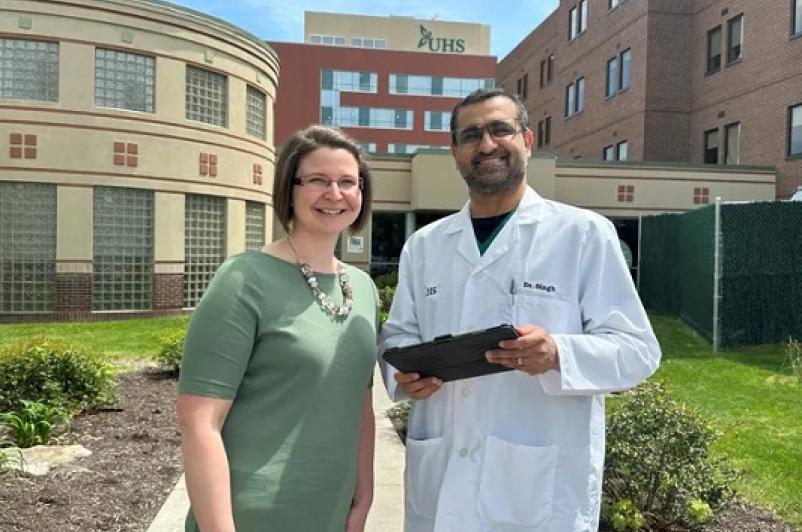

Acting fast gave stroke survivor a new lease on life
May 20, 2024
It was a typical Friday evening in February, heading into a long weekend for Chenango Forks school teacher Emily Silvanic. The mother of three was bathing her two youngest children when everything changed. After turning off the bath water and letting the kids play for a little before getting washed up, she noticed her vision going "fuzzy" and then suddenly, the entire right side of her body lost all feeling.
“Leading up to this time, I had no indication that anything was wrong with me and I felt completely fine,” said Ms. Silvanic. “As I went down to the floor I remember thinking, ‘This can't last for long and will go away.’”
But it didn’t, and Ms. Silvanic had no feeling, strength, or control in her right arm or leg, could not speak and was starting to go in and out of consciousness. It's estimated that she was on the floor for nearly 40 minutes before her husband and oldest child came back from a walk, heard the cries of the children in the tub and found her. Acting quickly, her husband and daughter called 911.
As Ms. Silvanic was placed in the ambulance, the driver asked her husband where he would like them to take her, and the first hospital that came to his mind was UHS Wilson Medical Center, a designated stroke center. It was a decision that saved her life.
After extensive testing, including a CT scan, it turned out that the main artery to Ms. Silvanic’s brain on her left side had burst and created 100% blockage of blood flow, causing a massive stroke. Amrinder Singh, MD, a neuro-interventional surgeon, and his team of stroke specialists performed emergency surgery to place a stent where the rupture had occurred and restore blood flow.
“Dr. Singh had told my husband I was about a half-hour away from it being too late and resulting in a fatal outcome,” said Ms. Silvanic. “We also found out that if it wasn't for the expertise and efficiency of those reading the CT scan and truly looking as close as they could to find the root of the problem, it would have been too late as well.”
After waking up in the Post- Anesthesia Care Unit, Ms. Silvanic started to realize she had feeling and movement in her right side again. She could lift her arm, make a fist, and move her leg. During her time at UHS, her care team was always there, helping her progress. Every hour, she would receive a routine check on her speech, memory, and motor skills. She worked with a speech and occupational therapist who helped her gain back what she had lost, less than 24 hours after the stroke occurred. Her team also did a series of blood work to see if she had any underlying conditions, a blood clotting disorder and/or any indication what would have caused this to begin with. Dr. Singh was regularly impressed by her progress, “reinforcing the fact that if I had not come in when I did, I would not be there sitting before him.”
As she celebrates National Stroke Awareness Month, Ms. Silvanic gratefully acknowledges her new lease on life: “It’s so important to know the symptoms of stroke and to act immediately. If I hadn’t gotten to the hospital when I did, it would have been catastrophic. With stroke, time lost is brain lost, so you must seek care quickly.”
The acronym BE FAST can help you remember key signs of stroke: B is for loss of balance, E is for eyes and loss of vision or double vision, F is for face drooping, A is for arm weakness, S is for speech difficulty and T is time to call 911.
“Things can happen in literally the blink of an eye that change your entire outlook on life forever. I learned that timing is everything,” Ms. Silvanic noted. “If I had had the stroke when I was sleeping, driving, or if I had been by myself, I would most certainly not be here today. If the ambulance was even five minutes late, I may not be here today.” She concluded:” I have three beautiful children and a loving husband who never left my side to get home to, and with Dr. Singh, his team, the medical professionals who got me to UHS, the entire staff who worked with me at UHS, and the many answered prayers I was able to walk out of UHS with a full and miraculous recovery.”
For more information about stroke or the designated stroke center at UHS Wilson Medical Center, visit nyuhs.org.

